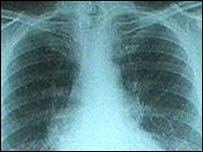|
By Caroline Ryan
Health reporter, BBC News
|


Cases of a rare lung condition were the first sign of the Aids epidemic
|
On 5 June 1981 a medical journal in the US published reports about five gay men who made up an unusual cluster of pneumonia cases in Los Angeles.
It was the first time the world was alerted to what would later become known as Aids - Acquired Immune Deficiency Syndrome, caused by HIV.
The research was published in Morbidity and Mortality Weekly Report, a journal published by the Centers for Disease Control.
In the early 1980s, Dr Jim Curran reviewed the paper before its publication and was made head of the CDC's taskforce to investigate the cases at the same time.
The paper detailed how five gay men, aged between 29 and 36, had been treated for Pneumocystis carinii pneumonia, a previously rare lung infection between October 1980 to May 1981.
However, it is now known that the organism which caused the disease is Pneumocystis jiroveci.
The five men also had cytomegalovirus (CMV), a form of herpes which is harmless to most people but which has since been found to problematic in those with HIV because they cannot fight off the infection.
Two of the men had already died by the time the paper was published.
An editorial note in the journal stated: "Pneumocystis pneumonia in the US is almost exclusively limited to immunosuppressed patients.
"The occurrence of Pneumocystosis in these five previously healthy individuals without a clinically apparent underlying immunodeficiency is unusual.
"The fact that these patients were all homosexuals suggests an association between some aspect of a homosexual lifestyle or disease acquired through sexual contact and pneumocystis pneumonia in this population."
'Common exposure'
The paper also said all five men had either had CMV disease or had shown signs of having the disease in the preceding months.
It said other research published earlier that year had found high rates of CMV among homosexual men, but not among heterosexual men of the same age.
A further study had found semen had tested positive for CMV in men whose urine had shown no sign of the virus.
 |
READ THE ORIGINAL PAPER
Most computers will open PDF documents automatically, but you may need Adobe Reader
|
The MMRW paper concluded: "These findings suggest not only that virus shedding [excretion of the virus] may be more readily detected in seminal fluid that in urine, but also that seminal fluid may be an important vehicle of CMV transmission."
It added: "The above observations suggest the possibility of a cellular-immune dysfunction related to a common exposure that predisposes individuals to opportunistic infections."
'Passionate campaigners'
Dr Curran told the BBC News website: "The paper was clearly important in terms of newness and severity. But the extent of the significance was clearly unknown.
"Our leading hypothesis from day one was that an underlying virus could be the cause of the epidemic.
"But it could have been an alteration of a current virus or a new one.
"It wasn't until cases were diagnosed in people with haemophilia around the summer of 1982 that there was uniform acceptance of the viral hypothesis.
"The paper's importance was incompletely recognised by politicians and the general public until it was proven to be transmitted through blood.
"But there were several passionate scientists, physicians and public advocates in and outside government."
'I saw him die'
The same issue of MMRW reported an unusually high number of cases of Kaposi's sarcoma, a rare type of cancer that develops from skin cells.
Twenty-six homosexual men under 50 - 20 in New York and six in California - had been diagnosed with the cancer in the preceding 30 months.
That compared three cases in one New York hospital between 1961 and 1979.
It was later discovered that Aids increases the risk of the cancer because of its effects on the immune system.
Dr Curran was asked to meet a young gay man with Kaposi's sarcoma a week after the article was published who was of the same age and who had had a virtually identical life to him.
"I got to know him and watched his health decline over the next several months, and saw him eventually die.
"I realised that it was a virus that really separated us and a virus that none of us could have known about. I've thought about that many, many times since then."
Dr Curran, now dean of the Rollins School of Public Health at Emory University in Atlanta, Georgia, added: "Twenty-five years seems like a long time in one sense but I can say that the time has gone by in a heartbeat.
"And I'm amazed at the scientific progress and the progress of many of the people who work to prevent the disease.
"But I'm even more amazed by the insidious, inexorable progress of the virus around the world."